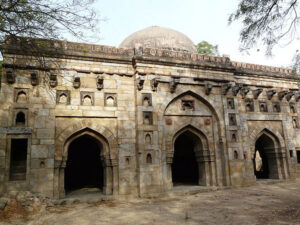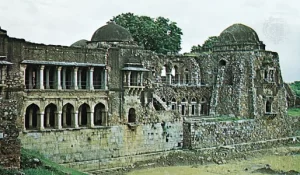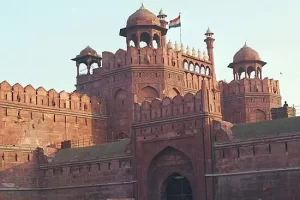“We face the good and the bad of India in Delhi city, which has been the grave of many empires and the nursery of a republic. What a tremendous story is here; the tradition of millennia of our history surrounds us at every step, and the procession of innumerable generations passes by before our eyes..”
It was Prime Minister Jawaharlal Nehru in his Convocation Address of the University of Delhi in December 1958, who talked about the succession of glory and disaster and the unwavering spirit of Delhi to remain itself. Maybe better words cannot be found to describe this land of cities. And among the sprawling national highways, never-ending traffic, new skyscrapers and corporate offices, and cushy buildings of embassies scattered around the region, there also lie remnants of history centuries old; some have stayed upright, some buried or dusted, yet the saga of Delhi continues.

The grand and opulent city of Indraprastha mentioned in the Hindu Purana Mahabharata is believed to have been located on the plains of Delhi. Even though the grandeur of the Indraprastha palace is vividly described in the Purana, no historically conclusive proof of its existence has been found. The earliest mention of Delhi as a city is found in the songs of Hindu bards. They have sung about a site that was abandoned and later repopulated after 792 years. An architectural relic (an inscription of Mauryan Emperor Ashoka) dated around 300 BCE would indicate the existence of a city in the Delhi plains, and the inscription on the Iron Pillar stating ‘Ang Pal built Delhi in AD 1052’ might indicate the veracity of the bards’ words. Ang Pal was a Tomar who was forced to leave Kannauj after attacks by Ghazni. This is believed to have led to their relocation to Delhi and the construction of the city of Lalkot. Later, Chauhan Rajputs conquered the region and renamed it Qila Rai Pithora.
With the defeat of Prithiviraj Chauhan in the hands of Mohammed Ghori in 1192, the Sultanate rule started, bringing with it their indigenous styles of architecture and culture. After Ghori’s death, Qutb-ud-din Aibak came to power, followed by Illtutmish and Razia. The famous Qutub Minar and Quwwat-ul Islam mosque complexes were built during their reign. During that period, to accommodate the growing population, the suburbs were spreading north-eastward. When the Khalji dynasty took control over the region in 1290 under Jalal-ud-din Firuz Khalji and later Ala-ud-din Khalji set their stronghold, the Khalji dynasty settled in the Siri region, building the second city of Delhi.
Ghiyath-al-Din Tughlaq came to power in 1320 and was unhappy with the security of Siri, so he built a city 5 miles eastward around a rocky hill, which gave him the isolation he preferred, the third city referred to as Tughlaqabad. But the rocky terrain posed the challenge of a dearth of steady water supply, hence leading to the abandonment of the city. Though the local lore tells a different story, the king was cursed by the saint Nizam-ud-din: “May it (the city) remain deserted or may it be a habitation of the Gujars (an agricultural-pastoral community). His successor, Muhammad-bin Tughlaq, built walls between Siri and Tughlaqabad to protect the vulnerable regions between both areas, hence the rise of the fourth city, Jahanpanah. And in 1354, four-five miles northeast of Siri, the next Tughlaq ruler, Firoz Shah Tughlaq, built Firozabad to house his version of Delhi. Interestingly, the mosque in the Firoz Shah Kotla complex attracts hordes of believers every Thursday nowadays who come there to pray to the djinns (spirits).
The later sultans of Delhi ruled from the confines of Firozabad, and when the Mughal ruler Babur defeated the last Lodhi ruler, he set his base in Agra. It was his son Humayun who built the city of Din Panah in the Delhi plains on the banks of the Yamuna. But when Humayun was overthrown by Sher Shah Suri, he reduced the city to ruins and built his new capital, Sher Shahi, or Shergarh, in southeast Delhi, now popularly known as Purana Qila. This is also the site believed to have housed the magnificent Indraprastha city of the Pandavas. The later Mughal rulers went back to Agra, and it was Shah Jahan, entering his new fort in 1648, who declared Shajahanbad, the new city built on the western bank of Yamuna, as his new capital. It took 8 years to build the city, majestic remnants of which still remain in the Old Delhi region today.

Lastly, on the razed-down remains of centuries of history, the bedrock of the largest democracy was built—the colonial rulers built Lutyon’s Delhi, or now New Delhi. Parliament building, executive offices, residential quarters of the heads of state, and commercial estates dot the landscape of the city, along with the deserted ruins of Tughlaqabad, the crumbled walls of Siri and Firozabad, and the and the lone remainders of the once resplendent Shajahanabad. If asked about this city that survived the vagaries of the river, the mercy of climate, and the whims of the rulers (dariya, badal, badshah) to any Delhite, they might unabashedly quote Ghalib and say,
“Ik roz apni rooh se poocha, ki dilli kya hai,
toh yun jawab main keh gaye,
yeh duniya mano jism hai aur dilli uski jaan”
(I asked my soul, ‘What is Delhi?’ It replied: ‘The world is the body, Delhi its soul’)

